Stomach Question And Answers
Question 1. Describe in detail the location and external features of the stomach.
Answer:
Stomach
- The stomachis a muscular bag between the abdominal part of the esophagus and the first part of the duodenum
- The stomach is the widest and most distensible part of GIT.
Stomach Location
- Stomach lies obliquely
- In the upper left part of the abdomen
- Stomach occupies:
- Left hypochondrium
- Epigastrium
- Umbilical region
- Most of it lies under cover of the left costal margin and the ribs
- Stomach Extent: From left hypochondrium to epigastric and umbilical region
Digestive System Class 10 Important Questions
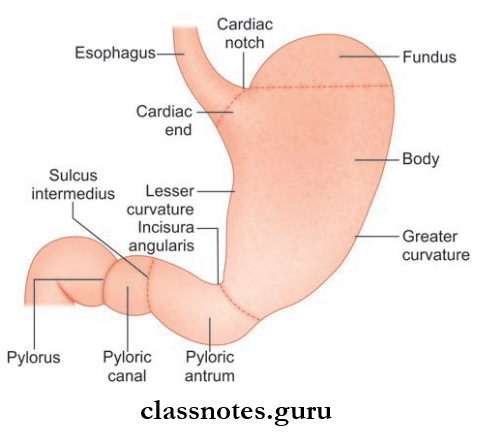
Read And Learn More: Abdomen And Pelvis
Stomach Shape:
- Jshaped: Empty stomach
- Pyriform Shape: Partially distended stomach
- Horizontal Stomach: Obese.
Stomach Size:
- Length: 25 cm
- Capacity: 1.5–2 L in adults
Stomach External Features: Stomach has
- Two Ends/Orifices: Cardiac and pyloric
- Two Curvatures: Greater curvature and lesser curvature
- Two Surfaces: Anterior/anterosuperior and posterior /posteroinferior.
Stomach Two Ends
- Cardiac End
- Cardiac End is the upper end receiving the lower end of esophagus
- Cardiac End has an opening—cardiac orifice
- Vertebral level—T1
- Lies posterior to left 7th costal cartilage
- Pyloric End
- Pyloric End is the lower end, which is continuous with the first part of the duodenum
- Pyloric End has an opening called pyloric orifice
- Vertebral level—L1
- Lies 1.2 cm to the right of median plane.
Human Digestive System Questions And Answers PDF
Stomach Two Curvatures
- Lesser Curvature
- The shorter right border of stomach
- Concave in shape
- Angular Notch/Incisura Angularis
- Most dependent part of the lesser curvature
- It marks the junction of the body and pyloric part of stomach
- Lesser curvature also provides attachment to the lesser omentum
- Greater Curvature
- Convex in shape
- The upper end has a notch, called the cardiac notch
- This cardiac notch separates the greater curvature from the left aspect of esophagus
- Greater Curvature provides Attachment To:
- Greater omentum
- Gastrosplenic ligament
- Gastrophrenic ligament.
Stomach Two Surfaces
- Anterior surface/anterosuperior surface
- Faces forwards and upwards
- Posterior surface/posteroinferior surface
- Faces backward and downwards.
Stomach Parts: Stomach has 4 parts
- Cardiac part
- Fundus part
- Body part
- Pyloric part
1. Cardiac Part: It surrounds the opening of the esophagus into the upper part of the stomach.
2. Fundus Pary: It is the area located above the level of the cardiac opening.
Fundus Pary Traube’s Space: This area overlies the fundus of the stomach and is tympanitic (hollow, high, drum-like sound)
Fundus Pary Boundaries
- Right Side: Left lobe of liver
- Left Side: Spleen
- Above: Lower margin of left lung resonance
- Below: Left costal margin
Fundus Pary Traube’s Space Is Obliterated In:
- Left-sided pleural effsion
- Massive splenomegaly
- Full Stomach
- Fundal growth
- Massive pericardial effusion
- Enlarged left lobe of the liver
Digestive System MCQ With Answers
3. Body Part: Largest region of the stomach, between the fundus and pylorus.
4. Pyloric Part:
- Pyloric is a funnel-shaped outflow part of the stomach
- Pyloric Is Divided Into Pyloric Antrum And Pyloric Canal
- Pyloric Antrum—proximal wide part
- Pyloric Canal—distal narrow tubular part
- The pyloric antrum and canal are separated by an inconstant sulcus in the greater curvature called as sulcus intermedius.
Question 2. Write a note on the relationship of the stomach and stomach bed.
Answer:
Relations Of Stomach And Stomach Bed
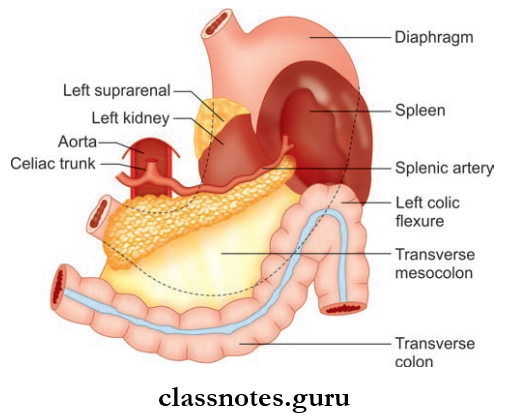
Stomach And Stomach Bed Peritoneal Relations
- The stomach is covered by the peritoneum on both surfaces except along the curvature (where blood vessels run) and a small part on the posterior surface of the stomach near the cardiac orifice called the bare area of the stomach
- Peritoneal layers covering the anterior and posterior surfaces meet at the lesser curvature and extend as lesser omentum
- Peritoneal layers also meet at the upper 2/3rd of greater curvature and extend as greater omentum
- Two layers of peritoneum meet near the fundus and form the gastrosplenic ligament
- From the uppermost part of the fundus, the peritoneal layer covering the posterior surface of the stomach extends as gastrophrenic ligament
Stomach And Stomach Bed Visceral Relations
- Anterior Surface
- Liver
- Diaphragm
- Rib cage
- Anterior abdominal wall
- Posterior Surface (The structures related posteriorly form the stomach bed)
- Diaphragm
- Left suprarenal gland
- Left kidney
- Pancreas
- Transverse mesocolon
- Splenic flexure of the colon
- Splenic artery
- Spleen—sometimes
The stomach bed is separated from the stomach by a lesser sac, except for the spleen which is separated by the greater sac
Mnemonic: STOMACH BED: Dr. Santa Singh killed The Patients Cruelly And Mercilessly (Diaphragm, Suprarenal gland, Spleen, Kidney, Transverse colon, Pancreas, Splenic flexure of Colon, splenic Artery, Transverse Mesocolon).
Important Questions On Human Digestive System
Question 3. Write a note on the interior of stomach.
Answer:
The Interior Of The Stomach

The Interior Part Of Stomach Presents With 3 Important Features, Namely:
- Gastric Rugae
- Gastric Pits
- Gastric Canal
1. Interior Part Of Gastric Rugae
- Gastric mucosa is thrown into numerous folds called as gastric rugae or gastric folds
- Rugae are longitudinal along the lesser curvature
- They are irregular in all other parts
- When the stomach is distended—rugae gets flattened.
2. Interior Part Of Gastric Pits: They are small depressions present on the mucosal surface.
3. Interior Part Of Gastric Canal
- Also known as magenstrasse
- It is the portion of the lumen of the stomach that lies along the lesser curvature, having longitudinal rugae
- It is formed temporarily during swallowing and allows rapid passage of swallowed liquids along the lesser curvature.
Digestive System Short Questions And Answers
Question 4. Briefly explain the blood supply, lymphatic drainage, and nerve supply of the stomach.
Answer:
Stomach Arterial Supply
- Along Lesser Curvature
- Left Gastric Artery: Direct branch of celiac trunk
- Right Gastric Artery: Branch of hepatic artery proper
- Along Greater Curvature
- Left Gastroepiploic Artery: Branch of splenic artery
- Right Gastroepiploic Artery: Branch of the gastroduodenal artery
- Short Gastric Artery (5–7 In Number): Branch of the splenic artery.
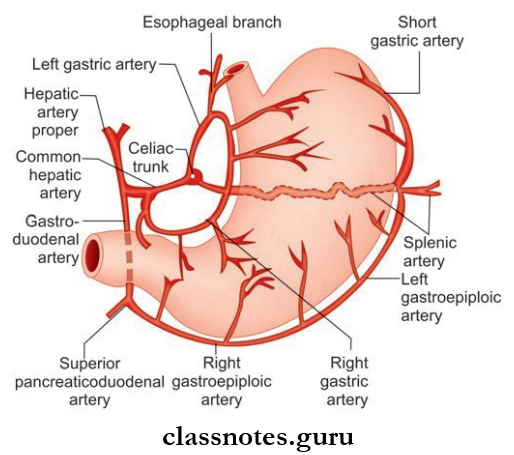
Venous Drainage Of The Stomach
- Veins accompany corresponding arteries
- Drains into portal vein, superior mesenteric vein, and splenic vein
Veins Of Stomach
- Right gastric vein
- Left gastric vein
- Right gastroepiploic vein
- Left gastroepiploic vein
- Short gastric veins
Drains Into Of Stomach
- Portal vein
- Superior mesenteric vein
- Splenic vein
Lymphatic Drainage Of Stomach
- Stomach can be divided into four lymphatic territories
- The first stomach is divided into right 2/3rd and left 1/3rd
- The right part is subdivided into upper 2/3rd and lower 1/3rd
- The left part is subdivided into upper 1/3rd and lower 2/3rd.
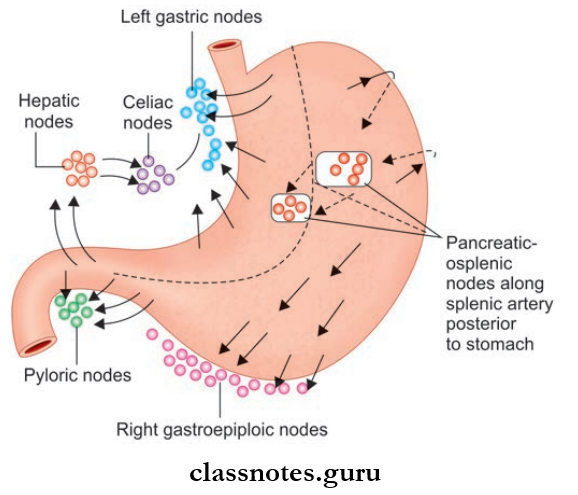
Digestive System Viva Questions And Answers
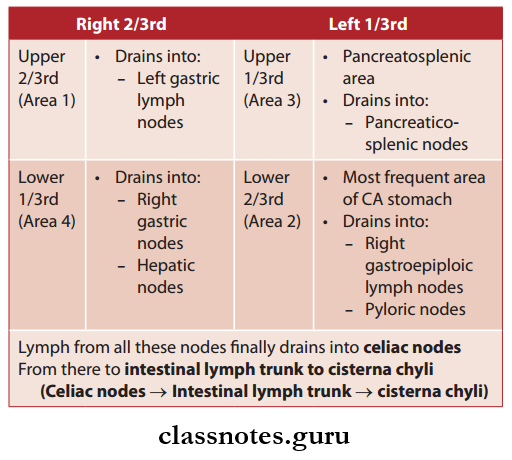
Stomach Nerve Supply
- Sympathetic Supply
- Derived from T6–T10 spinal segments
- Sympathetic Supply Through
- Greater splanchnic nerves
- Celiac plexus
- Hepatic plexus
- Sympathetic Supply Actions
- Vasomotor
- Motor to pyloric sphincter
- Pain sensation
- Parasympathetic supply
- Derived from vagus nerve
- Parasympathetic Supply Through
- Esophageal plexus
- Anterior and posterior gastric nerves
Stomach Applied Anatomy
- Since the upper part of the abdominal wall (epigastrium) is supplied by T6–T10, which is the same for the stomach
- So gastric pain is referred to the epigastric region.
Human Digestive System Neet Questions
Question 5. Write a note on the development of stomach.
Answer:
The Development Of Stomach

- Distal part of foregut shows a fusiform dilatation
- Ths dilatation represents the primitive stomach
- The primitive stomach has anterior and posterior borders, right and left surfaces
- The posterior border grows faster than the anterior border
- It undergoes 90 degrees clockwise rotation along the vertical axis
- As a result, left and right surfaces become anterior and posterior surfaces, and posterior and anterior borders give rise to greater (left border) and lesser (right border) curvatures respectively.
Stomach Multiple Choice Question And Answers
Question 1. The lesser curvature of the stomach is associated with which of the following ligaments?
- Gastrocolic
- Hepatogastric
- Hepatoduodenal
- Gastrocolic and hepatogastric
- All of the above
Answer: 2. Hepatogastric
Question 2. Referred stomach pain will be felt in what regions?
- Right hypochondriac and epigastric region
- Right hypochondriac and right lumbar region
- Left hypochondriac and epigastric region
- Left hypochondriac and left lumbar region
Answer: 3. Left hypochondriac and epigastric region
Digestive System Exam Questions And Answers
Question 3. Which of the following is absent in the stomach bed?
- Transverse colon
- 4th part of duodenum
- Transverse mesocolon
- Splenic artery
Answer: 2. 4th part of the duodenum
Question 4. Which is not true of the stomach?
- Completely invested by peritoneum T
- Cardia situated at T12 F–T11 according to Moore
- Pyloric opening at L1 T
- Aorta to the left of lesser curve F to the R
Supplied by branches of the celiac trunk
Answer: 2. Cardia situated at T12 F–T11 according to Moore And 4. Supplied by branches of the celiac trunk
Question 5. What is the function of parasympathetic nerves innervating stomach?
- Increase the mobility of stomach
- Increase secretion of pepsin
- Increase secretion of HCl
- Inhibitory to pyloric sphincter
Answer: 1. Increase the mobility of stomach
